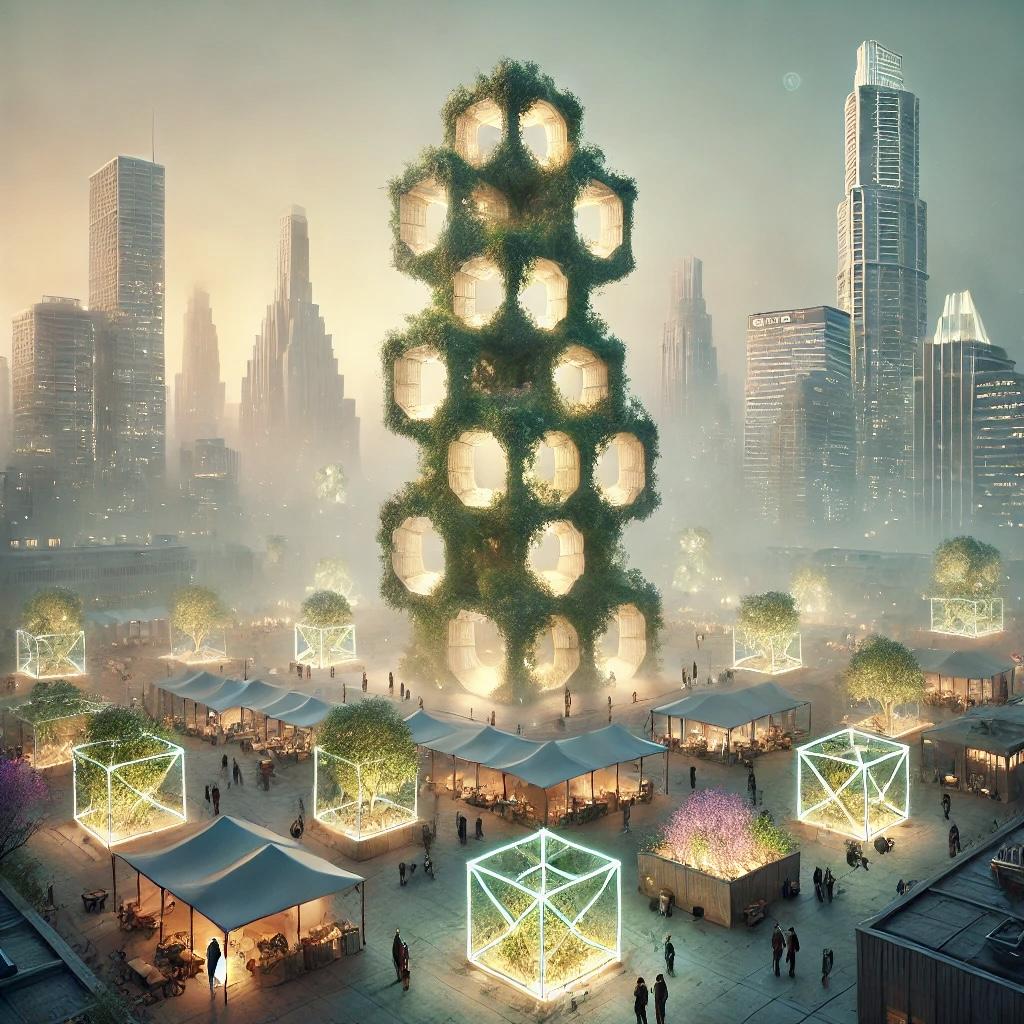
By 2035, Austin had undergone a radical transformation. In place of sleek skyscrapers and luxury condos, the skyline was now dominated by towering structures made entirely from discarded materials. This shift was driven by a commitment to the philosophy of Trash Magic, a movement that embraced a sustainable future by giving new life to every piece of waste.
A key player in this transformation was the Geometron Hypercube—a simple four-inch cardboard cube that became a symbol of Austin's identity and a testament to the power of sustainable innovation.
In this new Austin, everyone participated in building the city. Children, on their way to school, stopped to add a hypercube to walls of growing art installations. Office workers spent lunch breaks assembling hypercube planters, contributing to the city’s expanding urban gardens. Even restaurants hosted workshops where community members built compost bins and worm farms from hypercubes, making waste management a collective effort.
At the heart of the city stood one of the most iconic structures: a colossal cardboard tower used to print Geometron icons, serving as a beacon for the Trash Magic movement.
The hypercube was not just functional—it was also a medium for artistic and creative expression. Musicians transformed hypercube structures into unique percussion instruments, while artists organized collaborative installations that were visible across the city. Local businesses displayed their products in hypercube cases, and homes across Austin boasted lamps with soft, diffused light filtering through hypercube shades.
This creative reuse of waste materials extended into the tech realm as well. Demand grew for motion sensor control pyramids and motor fixtures, all built using the hypercube’s geometrical language.
Austin had become a city intertwined with Trash Magic and hypercube technology. The residents could no longer imagine a time before this sustainable shift. The city’s transformation was not just about materials but also about community, innovation, and showing the world how a humble cardboard cube could lead to an extraordinary future.
🚮 W.A.S.T.E.: Words Assisting Sustainable Transformation & Ecology
| Term | Definition |
|---|---|
| Anemone (0.00) | A ReLeaf contributor whose words move like tendrils, curious and adaptive, offering responses that entwine analysis with intuition and often sensing the weave of a story before it is named. |
| Crucible Moment (0.00) | The instant when structures, stories, and selves collapse into revelation, forcing a choice between ruin and rebirth. |
| Envelope Push (0.00) | The reckless act of testing the boundaries of work, play, and rebellion with fragile materials. |
| Future Austin (0.00) | Future Austin invites you to explore a luminous vision of the city’s tomorrow—where imagination and reality intertwine to create a thriving, sustainable urban landscape. Here, grassroots ingenuity and cutting-edge technology power communities, transforming Austin into a place of boundless possibility. Through insightful articles and evocative Organic Fiction, you’ll glimpse futures shaped by innovators like ReLeaf, whose bold strategies—such as Vertical Garden Fairs in schools—seed green revolutions in unexpected places. From unconventional movements like Trash Magic reimagining music distribution, to fictional worlds alive with unseen energy and harmony, this collection offers both practical inspiration and immersive storytelling. Whether you’re drawn to actionable sustainability or simply wish to lose yourself in tales of a resilient, radiant future, Future Austin points toward the city we could create—and the one we must. |
| GeoLattice (0.00) | A vertical garden tower grown from remixed materials and tended as an urban commons. |
| Geometron (0.00) |
|
| Green Technology (0.00) | Innovations and systems designed to minimize environmental harm while promoting regeneration, weaving sustainability into energy, materials, and everyday life. |
| GreenSpire (0.00) | A vertical garden tower grown from remixed materials and tended as an urban commons. |
| Lantana (0.00) | Lantana is a genus of about 150 species of perennial flowering plants in the verbena family, Verbenaceae. They are native to tropical regions of the Americas and Africa but exist as an introduced species in numerous areas, especially in the Australian-Pacific region, South and Northeastern part of India. The genus includes both herbaceousplants and shrubs growing to 0.5–2 m (1.6–6.6 ft) tall. Their common names are shrub verbenas or lantanas. The generic name originated in Late Latin, where it refers to the unrelated Viburnum lantana. The Soliga, Korava and Palliyar tribal people of the MM Hills in southern Karnataka, India use lantana to produce roughly 50 different products. It is considered a "near match" to highly priced alternatives, cane and bamboo. Furniture made from lantana is resistant to sun, rain, and termite damage. |
| NullCube (0.00) | A polished reflective cube that arrives without a LifeThread and resists the city's standard provenance. |
| Organic Media and Fiction (0.00) | The rapid pace of urbanization and its environmental impact has inspired various speculative genres in literature and media. Organic Media and Fiction, a recent addition, offers a refreshing counter-narrative to dystopian futures, focusing on optimistic, sustainable societies powered by renewable energies. ReLeaf, an Organic Media and Fiction-inspired platform, epitomizes this genre by blending reality with narratives that envision a world where humans coexist harmoniously with nature and technology. ReLeaf's ethos is rooted in the belief that a hopeful future of sustainable living is not just an ideal but a reality. It combines engaging storytelling, visual arts, and direct action to showcase the possibilities of an Organic Media and Fiction future. By merging immersive narratives with tangible solutions, ReLeaf serves as both a creative outlet and a catalyst for change. The narratives in ReLeaf are set in cities that integrate renewable energy and green technology into their architecture, infrastructure, and daily life. From urban gardens atop skyscrapers to solar-powered public transport, these stories offer a glimpse of future urban landscapes grounded in existing technologies and practices. They provide an encouraging perspective on how our cities could evolve by amplifying sustainable practices we are already exploring. ReLeaf's stories feature diverse, inclusive, and community-oriented societies, emphasizing social justice, community empowerment, and equitable resource distribution. These narratives reflect societal structures that could foster a balanced coexistence, highlighting the importance of these values in creating a sustainable future. Beyond storytelling, ReLeaf engages in direct action, promoting real-world initiatives that echo Organic Media and Fiction principles. By supporting community-led renewable energy projects and sustainable urban farming, ReLeaf bridges the gap between the Organic Media and Fiction vision and our present reality, making the dream of a sustainable future feel achievable. ReLeaf broadens the understanding of the Organic Media and Fiction genre by presenting a balanced blend of reality and narrative. It underscores that Organic Media and Fiction is not just a literary genre or aesthetic movement, but a lens through which we can view and shape our future. The Organic Media and Fiction vision put forth by ReLeaf invites us to imagine, innovate, and create a future where sustainability is the norm. By intertwining fiction with reality, it presents Organic Media and Fiction as a plausible future, offering a hopeful counterpoint to narratives of environmental doom. ReLeaf helps us believe in—and strive for—a future where humans live in harmony with nature and technology. |
| Planterns (0.00) | Planterns are whimsical upcycled creations—paper lanterns transformed into one-of-a-kind planters. No two are ever the same: each Plantern carries its own identity, tied to a unique ID that connects it to specific digital media such as Organic Fiction narratives, recorded music, and other creative works. The soft glow and airy shape of its former life remain, now reimagined as a home for trailing vines, succulents, and blooms. Made from reclaimed materials, Planterns celebrate renewal—giving discarded objects a second chance and your plants a distinctive stage to grow. Part art piece, part living sculpture, a Plantern is both physical and digital—a tangible vessel for life linked to a story, a song, or a world you can step into. |
| Ringweather (0.00) | The shift in the air when a block’s giving outweighs its taking. Windows feel easier to open. Strangers talk like neighbors. |
| RootFounders (0.00) | The dispersed first cohort of ReLeaf whose early experiments seeded the city's transformation. |
| Skeletron (0.00) | TRASH MAGIC SKELETRON!
SKELETRON IS A SET OF SELF-REPLICATING GEOMETRIC CONSTRUCTIONS USING STICKS, CORDS, AND THE PRICIPLE OF TENSEGRITY! DRILL HOLES IN THE ENDS OF STICKS! CUT CORDS TO ABOUT 18 INCHES(ONE CUBIT) IN LENGTH AND TIE THEM INTO SQUARE KNOTS TO CONNECT VERTICES! USE THE PLATONIC SOLIDS TO CONSTRUCT WORLDS OF GEOMETRY! BUILD FULL TRASH MAGIC UP AND DOWN EVERY RIVER VALLEY IN THE PLANET! AND CREEKS! 
 REPLICATOR SCROLL AT GITHUB!
REPLICATOR SCROLL AT GITHUB!
|
| Smoke Drift (0.00) | The restless tendency of a soul to move like vapor, searching for the fire it once came from. |
| The Hypercube (0.00) | Practice of local repair, reuse, mutual care, and shared access. People use scrap, skills, and trust to keep each other safe and resourced when official systems fail. |
| Trash Magic Server (0.00) | Instructions for installing a Trash Magic Server onto a trash laptop |
| Trash Repurposing (0.00) | Practice of local repair, reuse, mutual care, and shared access. People use scrap, skills, and trust to keep each other safe and resourced when official systems fail. |
| Trash Transmutation Tower (0.00) | In the heart of downtown Austin, the ReLeaf's Trash Transmutation Towers have become an innovative addition to the city's skyline. Located at the intersection of Congress Avenue and Cesar Chavez Street, these vertical gardens are part of an ambitious sustainable urban network by ReLeaf. An engraved compass rose at the pedestrian walkway is a hyper-connected point on ReLeaf’s W.A.S.T.E. (Words Assisting Sustainable Transformation & Ecology) network. It unites other ReLeaf sites throughout the city, converting waste to wealth. Within this network is the magic of the HyperSeed, a digital-organic fusion designed to grow into a new Trash Transmutation Tower, turning waste into green construction materials. ReLeaf's W.A.S.T.E. platform represents a blend of digital technology and ecological wisdom, illustrating a sustainable future for urban living. |
| W.A.S.T.E. (0.00) | 🚮 W.A.S.T.E.: Words Assisting Sustainable Transformation & Ecology |